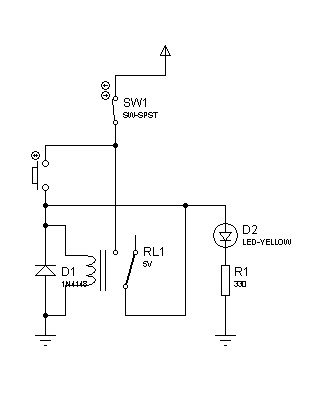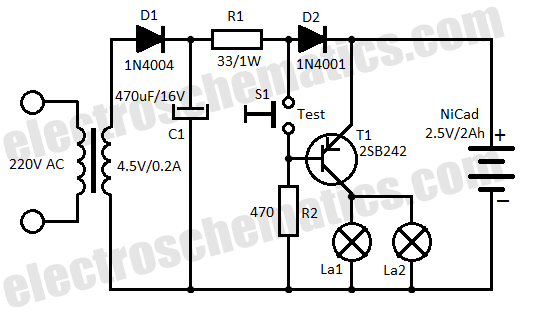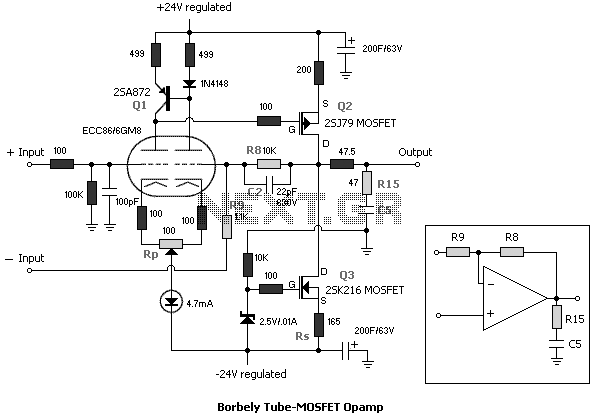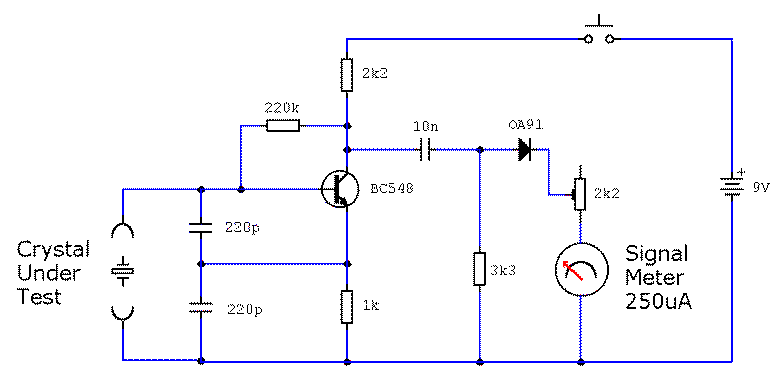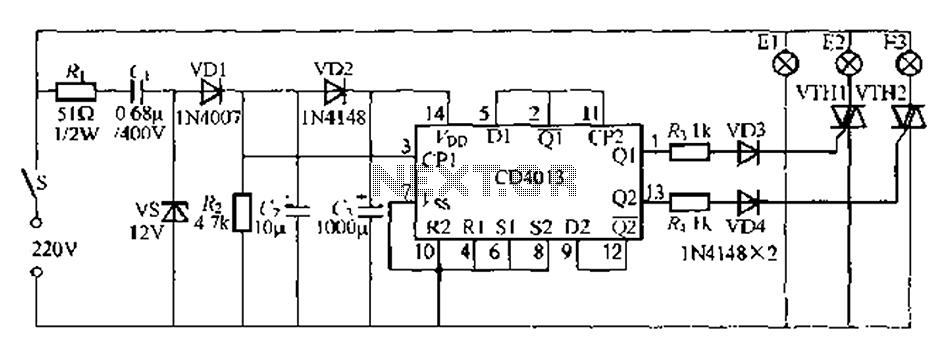
metal sensor detector circuit schematic

The metal detector circuit is presented here, illustrating a simple yet effective design. It utilizes a 40, 106 Hex Schmitt inverter IC, a capacitor, a search coil, and batteries. An advantage of connecting IC1b Pin 4 to a medium-wave radio antenna or wrapping it around the radio is noted. This circuit can also function as a hand-held metal detector, demonstrating a beat-frequency operation (BFO) capability of detecting objects up to 90 mm, such as a bottle cap. For maximum simplicity, the capacitor C1 can be omitted, allowing the circuit to achieve an impressive detection range of 150 mm for a bottle cap. However, operating at frequencies exceeding 4 MHz introduces instability issues. The TDA2822 component in the circuit oscillates at 230 kHz, with the possibility of frequency experimentation by altering the value of C1. A Faraday shield may be added to minimize ground effects and capacitive coupling, which connects to 0V. The inductance presents resistance to rapid voltage changes, causing a slight delay in charging C1, similar to the logical level of IC1a's 2-pole change. This necessitates rapid oscillations, which can be detected by an AM radio. Any change in the inductance of the search coil due to the presence of metal results in a frequency shift in the oscillator. While 230 kHz falls outside the medium-wave band, an AM radio can effectively pick up its harmonic frequencies. The design of the search coil L1 allows for some margin of error and is relatively conclusive. The coil is constructed with seventy turns of 30 SWG (0.315 mm) copper wire on a 120 mm diameter former. The metal detector is set up to utilize the AM radio to detect a whistle sound, which varies significantly with the presence of metal. This design is not intended for industrial or security applications and is not comparable to advanced metal detection systems like Loma or ERIEZ. It serves primarily as a basic, educational metal detection tool rather than a professional hand-held device.
The metal detector circuit employs a 40, 106 Hex Schmitt inverter IC, which serves as the core for signal processing. The integration of a capacitor and a search coil enhances the circuit's ability to detect metallic objects through beat-frequency oscillation. The circuit is powered by batteries, ensuring portability and ease of use.
The connection of IC1b Pin 4 to a medium-wave radio antenna or its wrapping around the radio facilitates the reception of oscillation frequencies, allowing the circuit to function as a hand-held metal detector. The beat-frequency operation enables the detection of objects like bottle caps, with an effective range of up to 90 mm. The omission of capacitor C1 simplifies the design further and extends the detection range to an impressive 150 mm, although this comes with the trade-off of increased frequency instability beyond 4 MHz.
The TDA2822 component is configured to oscillate at 230 kHz, a frequency that can be adjusted by modifying the capacitance of C1. The potential addition of a Faraday shield serves to mitigate interference from ground effects and capacitive coupling, connecting to the circuit's ground (0V). The inductance in the search coil introduces a resistance to rapid voltage changes, resulting in a delayed charging effect on C1, akin to the behavior of a logical level change in IC1a. This requirement for rapid oscillations enables the detection of frequency shifts by an AM radio.
The search coil, designated as L1, is designed with seventy turns of 30 SWG copper wire wound around a former with a diameter of 120 mm. This construction allows for a degree of tolerance in detection and is designed to be relatively conclusive. The metal detector utilizes an AM radio to interpret the oscillations, producing a whistle sound that varies in response to the presence of metal. It is essential to note that while this circuit demonstrates basic metal detection principles, it is not intended for professional or industrial applications and should be viewed as an educational tool rather than a sophisticated metal detection system.The metal detector circuit is shown here that the limits represent the sake of simplicity for a metal detector, but the design works remarkably well. It only uses 40, 106 Hex Schmitt inverter IC, a capacitor and a search coil and of course batteries. An advantage of IC1b Pin 4 is to be connected to a medium-wave radio antenna, or it should be w rapped around the radio. It can also be used as a hand-held metal detectors. As you can see what metal a good selection of beat-frequency operation (BFO), up to 90 mm for a bottle-top. In fact, for the ultimate in simplicity, the capacitor C1 is omitted. In this way, the author reaches is astonishing, 150mm range for the bottle top. But with the frequency then to more than 4 MHz, the instability is a major problem. TDA2822 As shown in the circuit, oscillates at 230kHz. You can also experiment with the frequency by changing the value of C1. Faraday shield can be added to reduce ground-effect and capacitive coupling, and this is connected to 0V.
Since the inductance is resistance to rapid change in voltage, the charging of fees C1 delayed a bit like the logical level IC1a 2-pole change. This requires a rapid oscillations, which is repealed by an AM radio. Any change in the inductance in the search coil (by the presence of metal) to a change in the oscillator frequency.
Although 230kHz is out of reach for the medium-wave band, an AM radio will significantly increase this frequency harmonics. This makes the search coil L1 is much room for error and is not far from conclusive. The author uses seventy turns 30 s. w. g. (0, 315 mm) copper wire on a former 120mm diameter. The metal detector, set up by the AM radio to pick up a whistle. Not all of these harmonic functions well, and are best suited to. The presence of metal will significantly change the sound of the whistle. This is not an industry or security metal detector and is not even near loma or ERIEZ metal detection system.
It`s just a notebook, but not hand-metal detector. 🔗 External reference
The metal detector circuit employs a 40, 106 Hex Schmitt inverter IC, which serves as the core for signal processing. The integration of a capacitor and a search coil enhances the circuit's ability to detect metallic objects through beat-frequency oscillation. The circuit is powered by batteries, ensuring portability and ease of use.
The connection of IC1b Pin 4 to a medium-wave radio antenna or its wrapping around the radio facilitates the reception of oscillation frequencies, allowing the circuit to function as a hand-held metal detector. The beat-frequency operation enables the detection of objects like bottle caps, with an effective range of up to 90 mm. The omission of capacitor C1 simplifies the design further and extends the detection range to an impressive 150 mm, although this comes with the trade-off of increased frequency instability beyond 4 MHz.
The TDA2822 component is configured to oscillate at 230 kHz, a frequency that can be adjusted by modifying the capacitance of C1. The potential addition of a Faraday shield serves to mitigate interference from ground effects and capacitive coupling, connecting to the circuit's ground (0V). The inductance in the search coil introduces a resistance to rapid voltage changes, resulting in a delayed charging effect on C1, akin to the behavior of a logical level change in IC1a. This requirement for rapid oscillations enables the detection of frequency shifts by an AM radio.
The search coil, designated as L1, is designed with seventy turns of 30 SWG copper wire wound around a former with a diameter of 120 mm. This construction allows for a degree of tolerance in detection and is designed to be relatively conclusive. The metal detector utilizes an AM radio to interpret the oscillations, producing a whistle sound that varies in response to the presence of metal. It is essential to note that while this circuit demonstrates basic metal detection principles, it is not intended for professional or industrial applications and should be viewed as an educational tool rather than a sophisticated metal detection system.The metal detector circuit is shown here that the limits represent the sake of simplicity for a metal detector, but the design works remarkably well. It only uses 40, 106 Hex Schmitt inverter IC, a capacitor and a search coil and of course batteries. An advantage of IC1b Pin 4 is to be connected to a medium-wave radio antenna, or it should be w rapped around the radio. It can also be used as a hand-held metal detectors. As you can see what metal a good selection of beat-frequency operation (BFO), up to 90 mm for a bottle-top. In fact, for the ultimate in simplicity, the capacitor C1 is omitted. In this way, the author reaches is astonishing, 150mm range for the bottle top. But with the frequency then to more than 4 MHz, the instability is a major problem. TDA2822 As shown in the circuit, oscillates at 230kHz. You can also experiment with the frequency by changing the value of C1. Faraday shield can be added to reduce ground-effect and capacitive coupling, and this is connected to 0V.
Since the inductance is resistance to rapid change in voltage, the charging of fees C1 delayed a bit like the logical level IC1a 2-pole change. This requires a rapid oscillations, which is repealed by an AM radio. Any change in the inductance in the search coil (by the presence of metal) to a change in the oscillator frequency.
Although 230kHz is out of reach for the medium-wave band, an AM radio will significantly increase this frequency harmonics. This makes the search coil L1 is much room for error and is not far from conclusive. The author uses seventy turns 30 s. w. g. (0, 315 mm) copper wire on a former 120mm diameter. The metal detector, set up by the AM radio to pick up a whistle. Not all of these harmonic functions well, and are best suited to. The presence of metal will significantly change the sound of the whistle. This is not an industry or security metal detector and is not even near loma or ERIEZ metal detection system.
It`s just a notebook, but not hand-metal detector. 🔗 External reference
